Preview: All-New Rivian R2 and R3 Electric SUVs
The sporty, smaller R2 SUV will start at $45,000 in 2026, with a lower-cost R3 hatchback to follow
California-based Rivian has introduced its next products based on a new, smaller platform: the R2 SUV, R3 hatchback, and R3X performance “crossover” hatchback.
The R2 will be the first of the new models to launch, with a promised arrival in mid-2026. Like the larger R1S and R1T, these new five-passenger models promise blazing performance and a range of over 300 miles.
There are other similarities between the new, smallest Rivians and their larger siblings, in that they have a front trunk and a large center-mounted touchscreen that handles the infotainment and climate systems, along with the various vehicle settings.
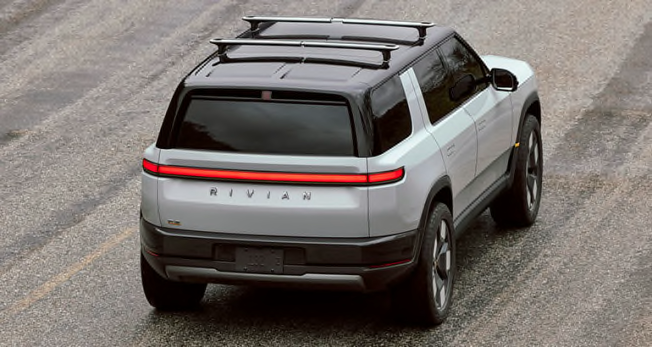
Photo: Rivian Photo: Rivian
CR's Take
Rivian launched with a midsized SUV and pickup priced deep into the luxury category. Now, the young automaker is moving more to the mainstream with its smaller platform that underpins the R2 and R3 models. With prices for the R2 starting around $45,000, that undercuts today’s average new car price, and by the time they roll out in 2026, that sticker may seem even more approachable—or will need to be adjusted. The R3 will be priced below the R2.
The R1S and R1T that we tested proved to be stunningly quick, highly agile, and outfitted with clever conveniences. The interiors felt more complete than the rather spartan Tesla aesthetic, but like Tesla, the overreliance on a large touchscreen for controls proved frustrating and distracting. In all, they represented a solid first salvo from the start-up company, with the notable caveats of a limited retailer base and below-average reliability. Both of those factors combine to make for a challenging ownership experience, as we have found when our test models needed warranty work.
With these upcoming models, Rivian has had time to gather owner feedback, address some criticisms such as the lack of front storage, and expand its range of offerings. We remain optimistic that related improvements will be meaningful.
The vehicles themselves should broaden the appeal of the brand. They each seemed poised to build on the brand virtues of distinct styling, standout performance, and electrified adventure.
Outside
The R2’s 185.6-inch length and 75-inch width measurements are very close to a Honda CR-V, although its 115.6-inch wheelbase is nearly 10 inches longer than that compact SUV—a potential boon to interior packaging. The R3 is about 5 inches shorter in overall length, making it more like the Hyundai Ioniq 5 in size and shape.
The exterior resembles the R1S, with two ovoid lights positioned vertically on the left and right third of the SUV’s front end. They are connected by a horizontal light bar that stretches the width of the nose. The top of the light bar hides the seam of the front trunk’s clamshell lid. Like the R1 SUV and pickup truck, the front fascia of the R2 is mostly flat and devoid of faux grilles or other design elements other than large tow hooks that are positioned lower down beneath each headlight.
Like the bigger Rivians, the R2 has a slab-sided design, with few seams and creases. The front and rear doors use the automaker’s flush door handles, which present themselves when the vehicle is unlocked or the driver approaches with the key fob. The windshield pillar and the B-pillar between the front and rear doors are covered in black, giving a seamless, wraparound look to the glass, while the roof pillar behind the rear roof is body color. The rear-most pillar is, again, black, and continues the wraparound effect to the rear window.
At the tail is a wide rear window that houses the first R2 trick: It can be power-lowered into the tailgate, like the Fisker Ocean and previous-generation Toyota Sequoia. This provides airflow as well as the ability to load and/or haul longer items without having to use a roof rack. In addition, the rear-quarter windows can be popped open to allow pass-through venting.
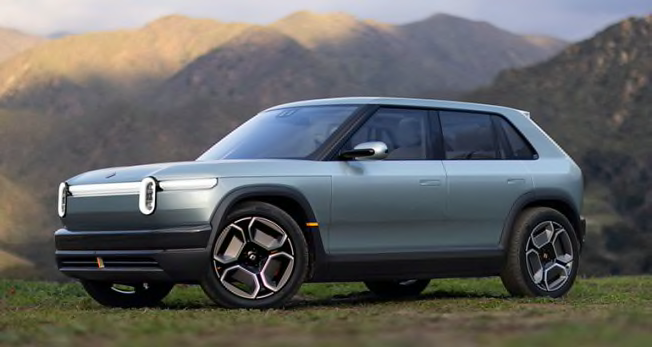
Photo: Rivian Photo: Rivian
Below this is a horizontal light bar that wraps around the rear quarter panels, forming tail and backup lights, with Rivian spelled out in large block letters below.
Large black plastic panels cover the front and rear bumpers, wrapping into the black plastic wheel arches and lower sills on the side of the R2.
The R2 is noticeably smaller than the R1S in every way. It’s 15 inches shorter than the three-row R1S; the wheelbase is 115.5 inches, 6 inches shorter than the R1S; and it’s about 67 inches tall, while the R1S’ height is more than 72 inches.
Rivian terms the R3 as a midsized crossover, although you wouldn’t be doing it a disservice to call it a hatchback. (Or even midsized.) It looks as if it would have been right at home alongside a Lancia Delta four-door hatchback in the 1980s. Rivian says only that the R3 is a few inches shorter than the R2—with most of the size coming out of the cargo area.
Inside
At first glance, the interior will be familiar to anyone who has sat in or driven an R1S or R1T, with evolutionary changes throughout the cabin.
One big change is that the automaker apparently listened to criticism about the lack of a glovebox in the R1S and R1T—so it put two power-operated ones in the R2 (shown below). One is located in the traditional spot in front of the passenger, while the second is positioned next to it, directly beneath the infotainment screen.
There is still a big, open floor-mounted space between the front footwells to hold items like a small bag, as well as a center console between the front seats that houses pop-out cup holders, a charging pad for mobile phones, a covered storage bin, and a pull-out drawer where the portable speaker lives in the R1 models.
The driver is greeted with a large steering wheel that can best be described as sqround: the top and bottom are flattened, though the sides are curved in a traditional way. Two large, knurled wheels—one on each side—are positioned in the middle of the wheel, replacing the small rollers that are used for different functions in the R1. Rivian says these “integrated haptic control dials make it easier to stay focused on the road,” and that they adjust based on the interface that the driver is using. We will, of course, put the R2 through our ADAS loop to see how much attention is required when using these controls.
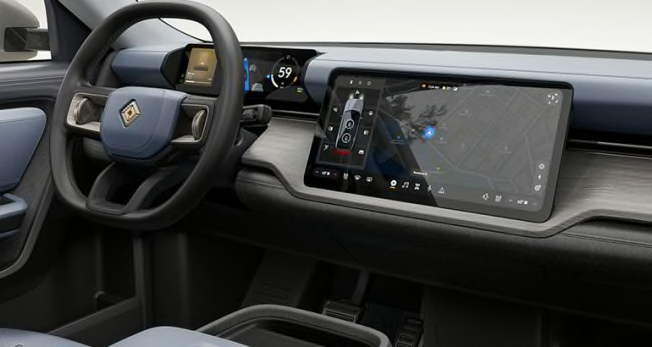
Photo: Rivian Photo: Rivian
A rectangular full-color screen sits in front of the driver. It is shorter than the screen in the R1S and R1T, and looks to have much of the same information as in those models, such as a speedometer, battery charge status, selected gear, navigation, current audio entertainment, and more.
Unlike the R1, with air vents below the large center-mounted touchscreen, the R2 appears to have a big vent for the driver below the gauge display.
A horizontal screen sits in the middle of the dash, housing the infotainment controls, climate functions, navigation, vehicle settings, and more features, just like in the R1. Rivian did not note the size of the display in its materials. Hopefully, it features Android Auto and Apple CarPlay, a convenience that is notably lacking in current Rivians.
During the introduction, Rivian founder and CEO RJ Scaringe made a point of noting that the R2’s doors don’t have a speaker in the same place as the R1 does, allowing a large water bottle to better fit in that space. As in the R1s, a small flashlight is housed in the driver’s door. We also see electronic buttons—similar to those in new Lexus models—to open the doors from inside instead of the traditional (albeit hard to find) handles in the R1s.
With the large battery sitting low in the R2’s chassis, the second-row seats should have plenty of foot room, thanks to the flat floor. The three-person bench seat can fold in three sections, creating a large, flat cargo area.
This is where another of the R2’s tricks come into play: Both front seats can also fold flat. When combined with the folded second-row seats, there is, according to Rivian, space for one or two people to sleep if they use an inflatable mattress. This is keeping with Rivian’s outdoorsy, go-anywhere attitude.
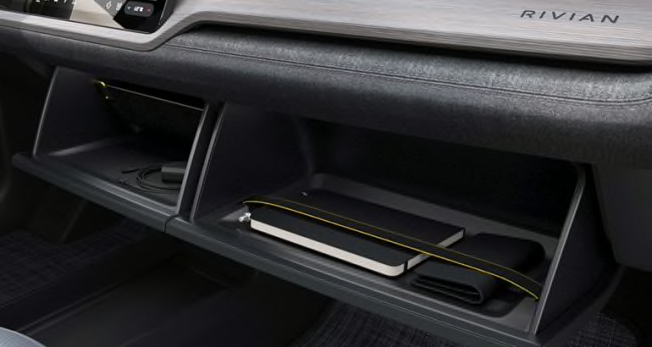
Photo: Rivian Photo: Rivian
What Drives It
The R2 and R3 will be offered in single (rear drive), double (all-wheel drive), and triple motor configurations (all-wheel drive). Rivian claims the triple-motor R2 will zip 0 to 60 mph in under 3 seconds. The R1S we tested sprinted from 0 to 60 mph in 3.5 seconds. With immediate throttle response, the thrust is quite memorable.
Two battery packs will be offered, and the various configurations are said to have more than 300 miles of range.
These will be compatible with the North American Charge Standard (NACS) at launch—the Tesla plug that the industry is widely adopting to allow access to the Supercharger network. With either NACS or the currently common CCS (with adapter) connections, these EV are said to be capable of charging from 10 to 80 percent in less than 30 minutes.
Rivian is utilizing new chassis and battery construction techniques to simplify the new platform and maximize space compared with the R1s.
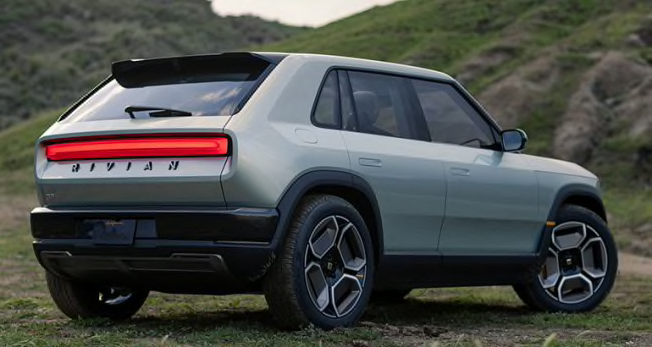
Photo: Rivian Photo: Rivian
Active Safety and Driver Assistance
Rivian hasn’t released much tangible information on safety systems on the R2 and R3. Consumers should expect that the same comprehensive suite of systems on the R1 models will be on these, including automatic emergency braking with pedestrian detection, automatic emergency braking that operates at highway speeds, blind spot warning, rear cross traffic warning, lane centering assistance, lane departure warning, lane keeping assistance, adaptive cruise control, and automatic high beams.
The automaker did say that the new “perception stack” features 11 cameras, five radars, and a more powerful computer program, and that it will give the R2 and R3 “dramatically enhanced autonomous capabilities” for hands-free driving on highways.
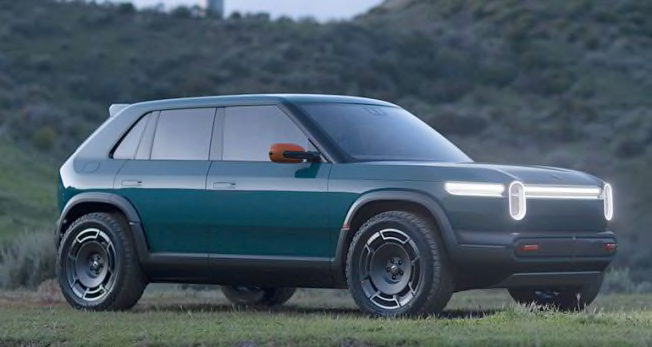
Photo: Rivian Photo: Rivian
















